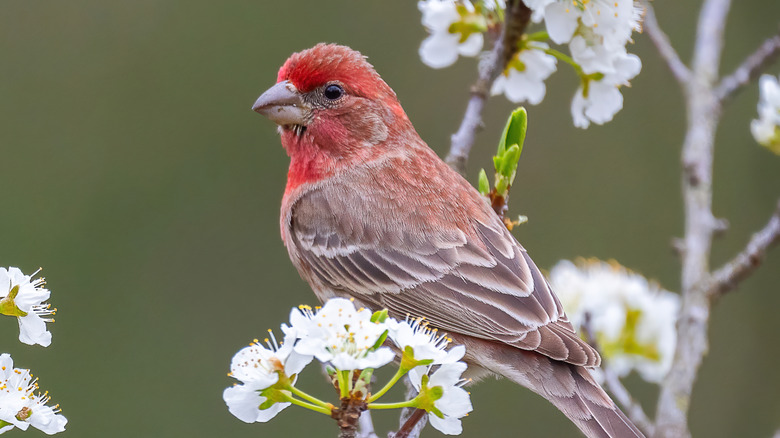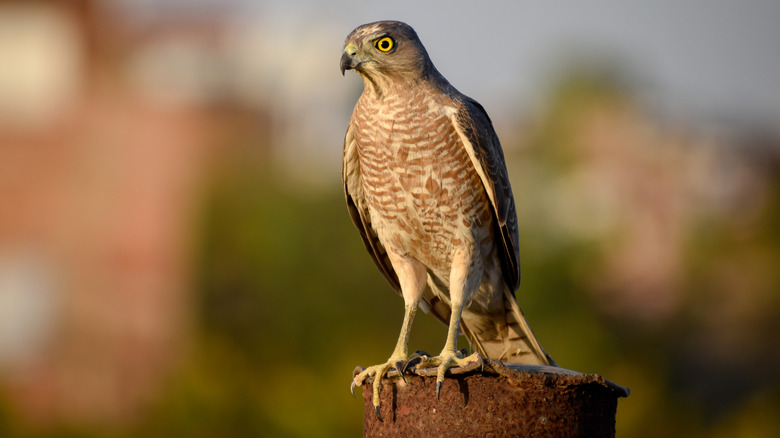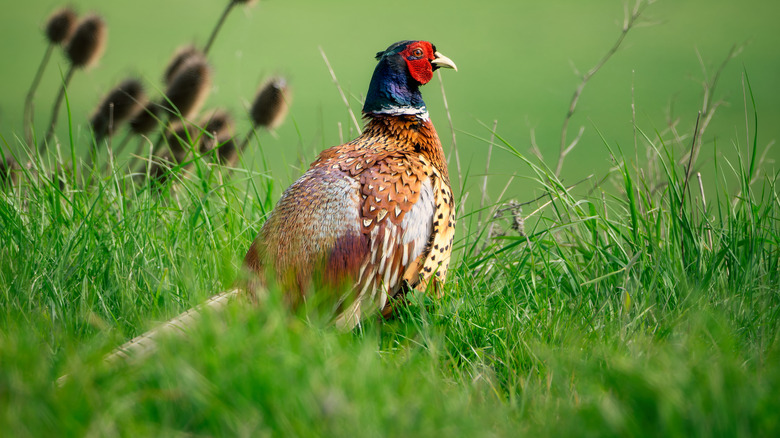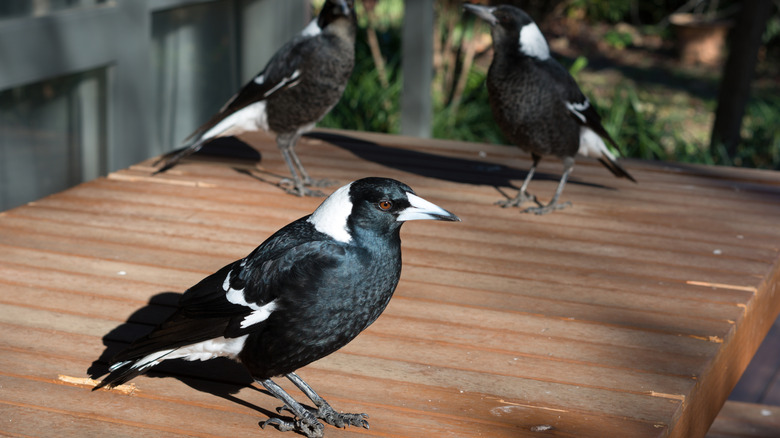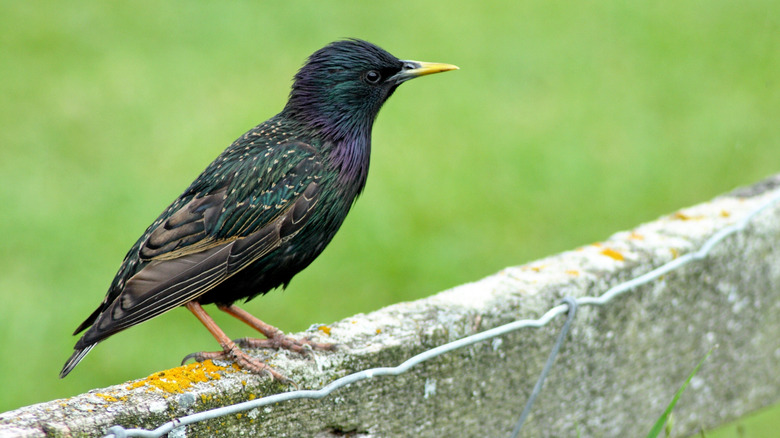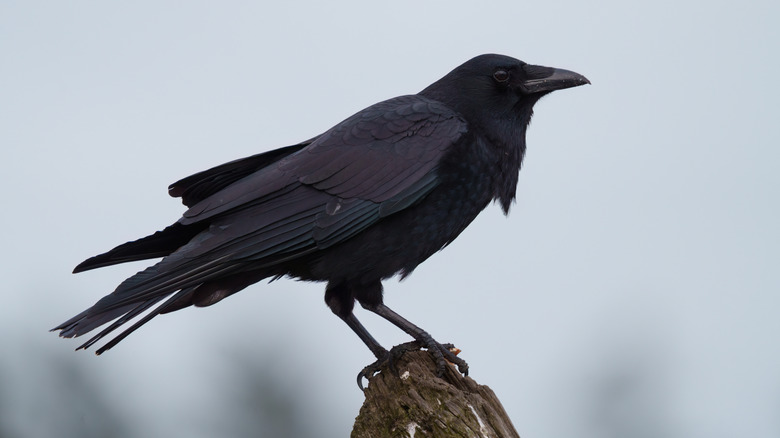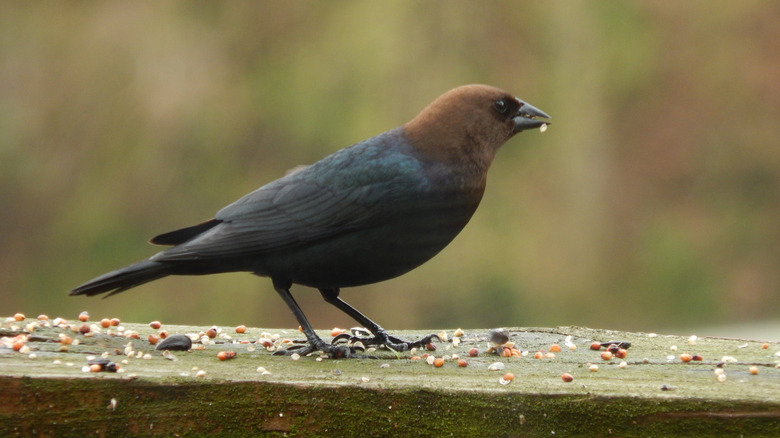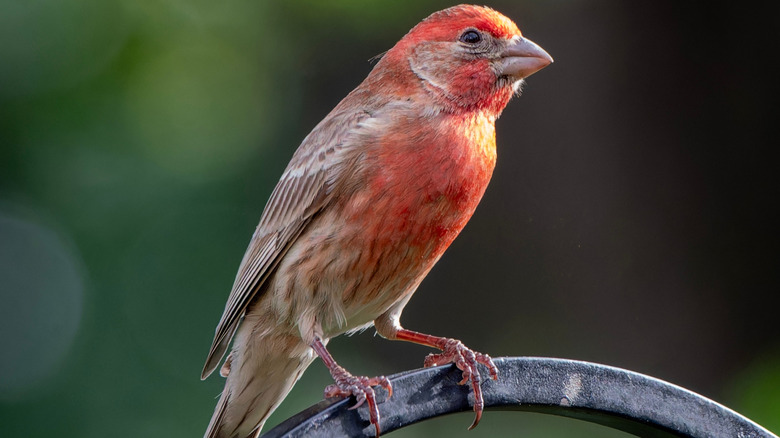Common Birds You Don't Want To Spot Flying Anywhere Near Your Yard
As you reward feathered friends with food and water in your backyard, you get to enjoy connecting with nature as they sing their melodic songs. Although birdwatching is a fascinating hobby, though, not all birds are welcome visitors. While some birds only swoop by to grab a snack, several common species can wreak havoc outside your home. A few are backyard bullies, known for stealing nests or attacking smaller songbirds. Others may destroy your yard, relentlessly make noise, or even attack humans and pets walking outside.
While some species pose more challenges than others, it's important to understand the specific issues each of these birds may bring. Meanwhile, remember that migratory birds and several other species are protected by law, meaning you cannot harm or kill them — and besides, humane solutions, like adding hawk or owl decoy statues to your yard, should always be the first choice. Either way, before you begin implementing deterrents, you should identify the following birds as the ones you'd rather not see out the bedroom window.
Scrub jay
At first, the scrub jay's bright blue feathers may make you excited to see it flying near your home, but this bird can be a nuisance to have around. While they may look cute and sweet, they have an aggressive side to them. Notorious for being territorial, these backyard bullies will scare off smaller birds at your feeders and even attack hummingbirds. Because they're so aggressive, songbirds will keep their distance if they see a scrub jay around. Aside from monopolizing feeding stations, these jays tend to save their food for later by burying acorns. Their unique hiding habits can be destructive, leaving behind small holes and damaged plants in your garden. Additionally, scrub jays are noisy, and their harsh, scratchy calls can be irritating, especially early in the morning.
To keep the jays at bay, start by swapping out open feeders for caged feeders. These guards work by allowing small species to access the seed while keeping larger birds, like scrub jays, from getting to the food at all. As a bonus, these deterrents tend to also keep squirrels from hogging all the bird seed. The main downside is that some models may make it challenging for medium-sized birds, like cardinals, to reach the tray. Once the scrub jays realize your backyard isn't the best spot for food, they'll likely find another place to eat.
Sharp-shinned hawk
It can be exciting to see a beautiful hawk soar through the sky near your yard. In addition to their majestic flying skills, these raptors are intelligent creatures with excellent eyesight and cunning hunting abilities. Hawks are stealthy, hiding in dense areas and moving quickly to snatch their prey before they even know what happened. Although they sometimes feed on small rodents, the bulk of their diet is songbirds. Thus, if you've attracted birds to your yard using feeding stations, you have inadvertently provided a buffet for sharp-shinned hawks. Even though they nest deep in the forest, their presence can see a seasonal increase near backyard feeders as their priorities shift from nesting to feeding in the winter.
If you've noticed hawk activity and want to protect your favorite feathered visitors, provide them a place to escape. Add shrubs and trees to your landscaping, specifically near your bird feeders, to allow small birds to hide quickly. As a bonus, choose fruit or seed-bearing varieties they can feed on. Birds are especially susceptible to attacks when feeding on the ground, so do your best to clean up fallen seeds and opt for hanging feeders. These measures should help, but if you have a persistent sharp-shinned hawk, it may be best to remove all of your feeders. The hawk will likely leave and hunt elsewhere without a readily available food supply.
Eastern kingbird
Eastern kingbirds may be relatively small, but don't let their appearance fool you. Although hawks may go for other songbirds in your yard, raptors may meet their match when faced with these bold little defenders. They're aggressive when it comes to protecting their nests and are ready to fight against larger predators or other birds if they come too close. While it's understandable they want to protect their nests, their territorial behavior extends past where they raise their young. Eastern kingbirds will relentlessly attack any birds in their territory, which may make other songbirds look for a more peaceful area to feed and nest.
Although eastern kingbirds aren't the worst species to have nearby, watching them regularly attack other birds can be jarring. Deterring this species can be a little tricky, especially if they've already made your backyard their chosen territory. Because they prefer open yards with scattered vegetation, adding more covered areas and more dense shrubbery may make your outdoor area less appealing. They also enjoy perching on high vantage points, like tall fences, to hunt for prey. Bird spikes are the go-to for preventing species like pigeons from landing and leaving droppings, but they could come in handy to deter eastern kingbirds from perching. These devices aren't meant to injure birds, so don't worry about that — they just encourage them to land elsewhere.
Ring-necked pheasant
If you see movement in a grassy area of your backyard, you could have an unexpected visitor. Despite the allure of their colorful feathers, ring-necked pheasants can cause a lot of damage in your garden. These large birds are ground foragers, meaning they scratch at the soil to search for food. As they use their bills to dig for insects, they can tear up your lawn, damage delicate flowers, and destroy vegetable plants. Bugs aren't the only food that lives beneath the soil; they may also remove roots to feed on. If that's not bad enough, these opportunistic feeders will also eat plant leaves, crops, flowers, and delicate buds in your garden. Additionally, they can be aggressive toward other ground-nesting birds and even use another species' nest to lay their eggs.
Although they're non-native, ring-necked pheasants may stumble into your yard if you're near their range or if they've been released nearby for hunters. If they're causing damage, consider installing a motion-activated sprinkler system to scare them away. You can also install fencing or netting to limit food sources and protect your crops from pheasants and other destructive pests. Eliminate large patches of weedy areas or tall grasses if feasible, as these lush plants provide both food and nesting areas for ring-necked pheasants.
Magpies
Magpies are close cousins of other intelligent birds like crows and ravens, and while fascinating, there are several reasons you want to avoid having them as backyard guests. These aggressive birds will gather to mob attack nearly anyone, including you, your pets, and other birds in your yard. With the ability to recognize individual human faces, all it takes is mistakenly getting too close to their nest to have an avian enemy for a long time. To make matters worse, magpies eat almost anything they can get their beaks on. They'll tip things over if they suspect there may be food underneath or dig up your yard to find worms and insects. Nearby nesting birds aren't safe either, as magpies will even eat eggs and hatchlings.
If magpies are terrorizing your backyard, devices like reflective bird scare tape can be beneficial. These shimmery streams work by rustling about in the wind, creating noise, and simultaneously reflecting light in several directions, which can disorient and scare magpies away. Place stakes into the ground around the area you want to protect. Attach the tape to the first stake, about 18 inches high, and twist it around a few times before tying it to the other posts. Make sure there's enough slack that the wind can easily move it, allowing it to shine repeatedly with each gust. You'll need to reposition tape and other scare devices at least once per week to prevent the magpies from adapting to them.
American robins
Although robins sing beautiful songs and look pretty flitting around the yard, they have a few less-than-redeeming qualities. As they forage for food on the ground, they can tear up your once well-manicured lawn. Because they travel in flocks, you could have dozens of these tiny birds scratching up the dirt at once. Even worse, robins can be especially destructive to crops. They'll repeatedly peck at fruits, sometimes even destroying the entire harvest. Additionally, robins can indirectly spread Lyme disease by carrying and leaving behind infected ticks. As if that wasn't bad enough, they're also considered "super-spreaders" of the West Nile virus because they're highly susceptible to getting it and can host it, which then gets transmitted to humans through mosquito bites.
Luckily, robins can be spooked somewhat easily and don't like sudden noises or movements. Motion-activated sprinklers work well because when the robins fly by and turn them on, the sudden sound and water splashes scare them away. Another option to get rid of robins is to install noisemakers, like windchimes, as the unfamiliar sounds will startle them. If you notice any nests in your yard, wait until the hatchlings fly away and take it down. Although they typically make a new nest, robins sometimes build on top of an old one, so removing it may prevent them from returning.
European starlings
European starlings are notoriously aggressive and travel in large, noisy flocks that can quickly take over your bird feeders and drive native species away. Aside from bullying other birds, starlings also have an annoying habit of digging through gardens to search for insects, leaving behind a mess of soil and damaged plants. They're also fond of fruit crops, and their repeated pecks can leave plants vulnerable to disease. Starlings aren't picky when choosing a nesting spot either and often take over more desirable bird nests, like bluebirds. Add in the fact that they are another bird which is known to harbor diseases, and it's best to deter them from your yard.
To prevent starlings from taking over, use feeders specifically designed for smaller birds. For example, a bird feeder with a weight-sensitive perch that collapses under the weight of a starling. If you don't want to swap out food stations, try opting for safflower seeds, which starlings find less appealing. If they've built nests in an unwanted place, like a vent, cover these areas with a bird netting to discourage them from returning.
American crows
Although crows are highly intelligent and fascinating to watch, they can be a headache for gardeners. Crows are opportunistic feeders and won't turn down a quick snack from your vegetable garden, especially if you grow corn. If they don't find any worthwhile crops, they may scavenge through the trash, creating an unsanitary mess outside. They're also notorious nest predators and will eat baby birds or eggs in the nests of favored songbirds. Plus, they're noisy animals, and their loud caws can go from a little irritating to downright unbearable.
One effective way to discourage crows from flocking to your yard is to eliminate easy food sources. Make sure your trash cans and compost piles have secure lids, and immediately clean up any fallen scraps. Scarecrows got their name for a reason, and they don't have to be the stereotypical straw-stuffed clothing type to work. If you employ a human-like model, dress it in brightly colored clothes and relocate the scarecrow often for best results. Mechanical visual deterrents are even better because crows don't adapt to them as quickly. Lastly, add a few shrubs or trees to give other birds a spot to build well-hidden nests.
Brown-headed cowbirds
You may not notice the destruction of brown-headed cowbirds as easily as other species, like European starlings. However, nesting birds in your yard will surely be stressed to see these birds nearby. Brown-headed cowbirds practice obligate brood parasitism, meaning instead of building their own nests, they lay eggs in the nests of other birds. Cowbirds are cunning and sneaky, carefully watching as a different mother bird prepares her nest and lays her eggs. Once the brown-headed cowbird sneaks an egg into the host female's nest, she has no idea she's got extra young to care for. Species like cardinals, warblers, vireos, and hundreds of others are frequent victims whose own hatchlings tend to suffer as a result. The cowbird nestlings will beg for food more than the host female's young, so the intruder gets more food than her babies.
To reduce cowbird activity, avoid placing open feeding trays on the ground, as they prefer to forage in open areas. Tube feeders or those with smaller perches are ideal because they're less accessible for medium-sized birds. Brown-headed cowbirds love bird food packed with millet, sunflower seeds, and cracked corn, so opt for less desirable options like safflower seeds, whole peanuts, suet, or nyjer seeds.
House finch
Finches are undeniably cute and colorful, and many people welcome them in the gardens. However, house finches are considered invasive in some areas. They're voracious eaters, competing for food against native species, like purple finches, and will quickly deplete your feeders. Additionally, because they tend to gather in flocks, they're more able to out-compete other songbirds for resources. Additionally, they are carriers of house finch eye disease, a bacterial illness that's a form of conjunctivitis. Although most birds aren't at risk, it can spread to other house finches and American goldfinches. When infected, these birds often become blind, making them targets for predators. Worse yet, these birds can also carry salmonellosis, which can spread to other birds, pets, and even humans.
The easiest way to keep house finches out of your yard is to limit their available food. Switch to a seed mix they don't prefer, like safflower seeds or nyjer. Consider installing upside-down feeders with the feeding holes underneath the perching area. House finches rarely hang upside down to feed, so they're more likely to look elsewhere for food. As a bonus, this design also keeps out other nuisance birds, like house sparrows.
Northern mockingbird
As the state bird of five states, are northern mockingbirds really that bad to have singing in your yard? To be fair, they aren't the worst visitor you could have in your yard, but you should still welcome them with caution. While they can be fun to observe, they're incredibly territorial during the nesting season. Northern mockingbirds typically build their nests between three and 10 feet off the ground, so you could easily pass by one without realizing it. They're known to dive-bomb anyone who gets too close, including other birds, pets, and humans. Not only are they protective of their young, but they'll monopolize their chosen food sources, including feeders, chasing off any other birds who dare go near them. Male mockingbirds may also sing loudly in the middle of the night to attract a mate, which will keep you up rather than lull you to sleep.
If a mockingbird has claimed your backyard as its own, try creating more space between feeders and adding dense shrubbery to give other birds refuge. By doing so, you give the mockingbird its own special feeding area, and it'll likely stick to its chosen spot. Keep the mockingbird feeder far away from the others, and fill it with their favorite treats like suet and dried fruits. To get rid of mockingbirds from your yard, cover your fruit trees with bird netting to limit their favorite foods. Additionally, a little pest control can eliminate their top source of protein: insects.
Red-winged blackbirds
Red-winged blackbirds are another beautiful species that can be a little aggressive once breeding season approaches. In fact, the male's primary life goal is to ward off any intruders that get too close as the female works on building the nest. They're another fearless flyer — attacking humans, pets, other birds, including raptors, and anything they deem a threat. Male red-winged blackbirds are also noisy as they defend their territories against other males. Momma birds aren't exactly docile, either, though they usually spend more energy warding off other females.
Because they nest near the ground, it can be challenging to stay away from their attack zone. Avoid walking under low branches where they may build their nests, and stay away from any you see in your backyard. To prevent red-winged blackbirds from taking over, limit accessible food as much as possible. Because they sometimes snack on berry bushes, protective netting can deter them while protecting your crops. As medium-sized birds, feeders with weight-sensitive perches or cages will also keep them from getting to feed. Even if you have an open feeder, use safflower seeds as they're difficult for them to eat, so they may look to other areas if that's their only source of food. Thankfully, these birds don't stick around for too long, so if all else fails, proceed with caution and wait for them to vacate on their own.
